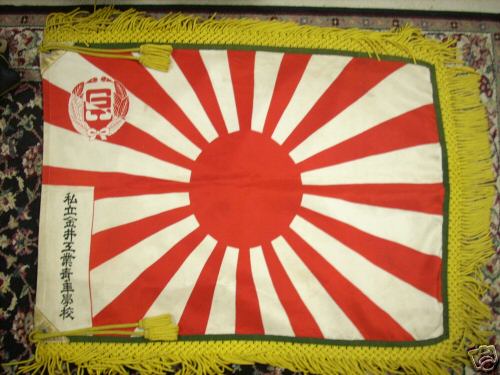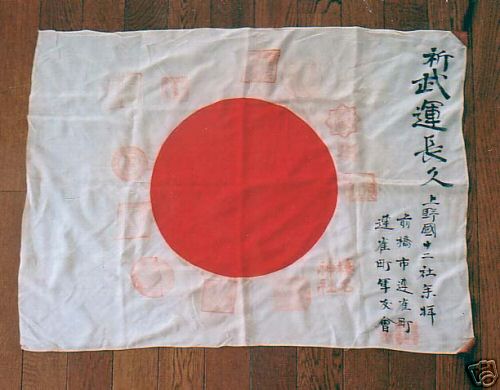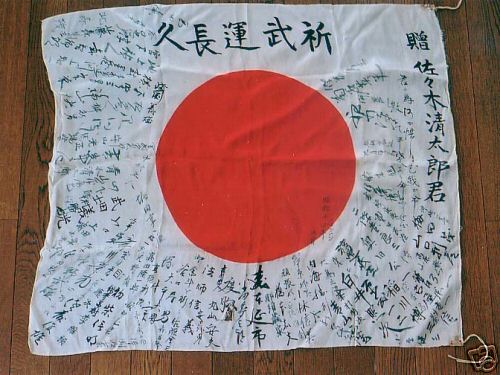
image contributed by Bill Garrison, 23 January 2008

Last modified: 2009-08-15 by phil nelson
Keywords: soldier flags | japan | world war ii | thousand stitch flag |
Links: FOTW homepage |
search |
disclaimer and copyright |
write us |
mirrors
See also:
The following question was received by FOTW:
My Dad was in Japan in World War 2 and brought back a Japanese flag. I was told that the Japanese soldiers would carry the flag folded inside their shirt and the flags were brightly painted with pictures and family names and/or prayers. I was also told that after the war, the U.S. men on the ships returning home from Japan made duplicates of these flags for souvenirs . I believe that I have one because on the bottom of the material is printed "U.S.N." Could you tell me more about these flags?
I heard that it was popular for Japanese soldiers to bring folded national Hinomaru
with family names and prayers for luck in the war and a thousand-stitch flag which
is long piece of cloth with one thousand red thread stitches sewn by one thousand
women. This was worn by soldiers as a good-luck belt to protect them against bullets
during World War II. In some cases flags with brightly painted strong animal like a tiger
or dragon were used.
Nozomi Kariyasu, 26 February 2002

image contributed by Bill Garrison, 23 January 2008
"[World War II] Japanese Rising Sun naval school flag. [...] The story
I got when I bought it was that this flag came from a naval school
in Japan during [World War II]. Each school had one of these flags named to them.
The flag was a focal point for the students and staff."
Bill Garrison, 23 January 2008 quoting E-Bay seller
The wording says Private School of Kanai Seiran Technology.
I am not sure if the school is a kind of navy school.
The sun seems to be placed in the center like the Imperial Army flag
at that time rather than the Imperial naval ensign.
Nozomi Kariyasu, 23 January 2008

image contributed by Bill Garrison, 25 February 2008

image contributed by Bill Garrison, 25 February 2008
From the E-Bay seller's description:
[Part of] a rare group of items from the Nomonhan Incident (Battle of Khalkin-Gol), 1939; all the former property of a Kwantung Army officer named Sasaki Seitaro. This next item is Sasaki's signed Hinomaru Battle flag made of silk and measuring 27 1/2 X 31 1/2 inches. It is dated Showa 14 (1939), August, Nomonhan, in Japanese. [...] Background: In the months prior to the Nomonhan Incident, the Japanese Kwantung Army Command made a fatal miscalculation. According to Japanese intelligence, Stalin's purges had weakened the USSR's capacity to respond to a military challenge in the region. In April, 1939, the 23rd Division of the Kwantung Army moved against Outer Mongolia. Starting in May, Soviet bombers attacked Manchukuo and Imperial Japanese bombers retaliated. These were among the greatest air battles ever recorded with 150-200 war plane formations. The Soviet response was to dispatch Lieutenant-General Georgi Zhukov to the region in July, 1939. The Red Army's surprise assault began in August, 1939, with a thrust into Western Manchukuo. The superiority of the Soviet mechanized units resulted in repeat reversals for the Japanese. At the Battle of Khalkin-Gol (Nomonhan to the Japanese), Zhukov's forces wiped out the Japanese 23rd Division. When the fighting was over, 18,000 Japanese were dead, and another 20,000 wounded. In the wake of this defeat, which was kept a secret from the Japanese public, Japanese military planners gave up the "Go North" strategy and began to probe areas sensitive to the United States, thus culminating in the attack on Pearl Harbor in December, 1941. A very historic signed Japanese Hinomaru Battle flag.
Bill Garrison, 25 February 2008